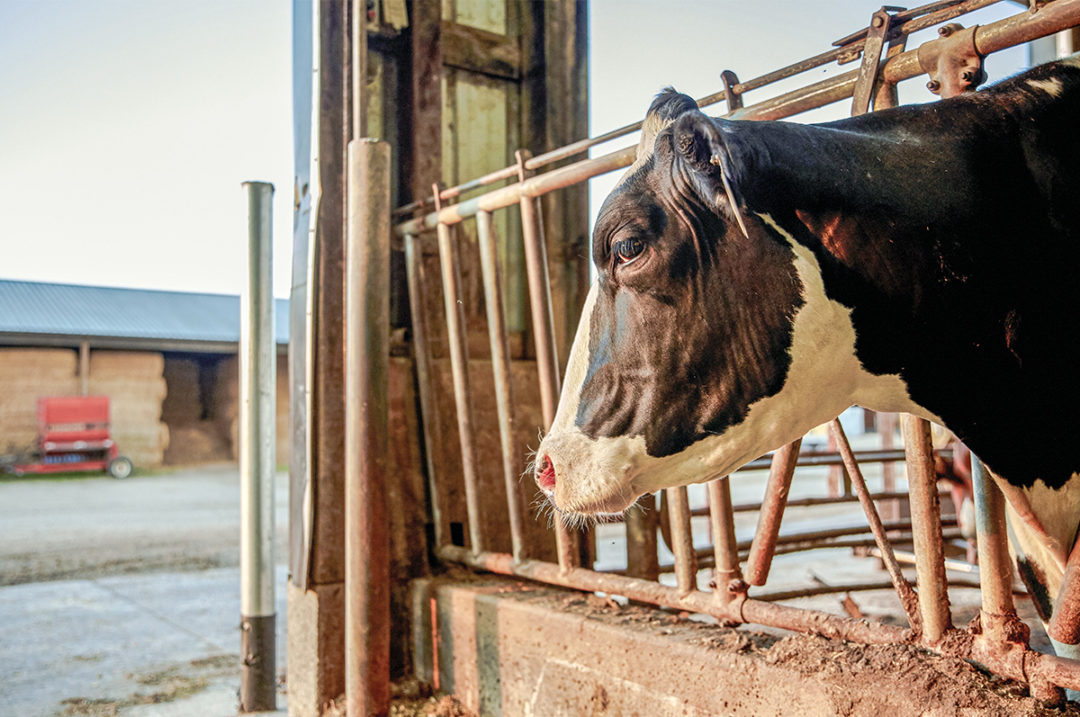Heat stress occurs when an animal generates and absorbs more heat than it can dissipate through respiration, sweating or active cooling. Rumination generates large amounts of heat, so when a cow is hot, her first response is typically to eat less feed. As heat stress sets in, the following occurs:
- Reduced rumen function
- Dip in milk production
- Lower reproduction
- Slower growth rates
Lower milk production typically garners the most immediate response from producers. However, the impacts of heat stress on dry cows should also be acknowledged. Researchers from the University of Florida observed the effects of heat stress on dry cows and their offspring in utero. Reports show that these offspring can lose as much as 10 pounds per cow per day as compared to their herdmates.
During heat stress season, try these practical strategies for adjusting nutrition and feeding practices:
Always offer fresh, clean, drinking water
This is the single most important nutritional strategy. Cows lose body heat through panting and sweating – this requires substantial amounts of water. Cows need water to release heat and control their body temperature. Although cows do not seem to have a preference for water temperature, drinking cooler water reduces respiration rate and body temperature faster than warmer water. Additionally, testing the water for minerals, hardness and cleanliness can offer producers insight and opportunities for improving water. Ultimately, increasing water intake is positively correlated to feed intake and, in turn, improved health and production.
Feed cows at night
Nutrition is about what to feed and when to feed. To control body temperature during the summer months, cows will spend less time eating and will avoid eating during the hottest hours of the day. In fact, cows can consume 2/3 of their diet during cooler nighttime temperatures. If feeding once daily, feed at night. If feeding cows twice or more daily, feed 70%-80% of their daily allowance at night.
Include organic acids in the mixer wagon to keep feed fresher for longer
Warmer outside temperatures can cause fresh feed to deteriorate more quickly when exposed to oxygen because yeast and mold favor heat. Certain organic acids can work as TMR (total mixed ration) stabilizers when added to the ration in the mixer wagon, extending the bunk life of fresh feed. A three-acid blend of acetic, benzoic and propionic acids is ideal to control yeast populations and protect rations against mold and mildew.
Reformulate diets but avoid overfeeding nutrients
You may need to reformulate diets and adjust nutrient concentrations to reflect lower feed intakes during the summer months. Nonetheless, overfeeding nutrients is not a sound approach to mitigating heat stress. In fact, several heat stress studies have shown that increasing the net intake of energy or protein does not necessarily improve energy-corrected milk production. Instead, make sure your diets meet nutrient requirements based on nutrient concentrations to avoid overfeeding. Feeding nutrients in excess comes with both a financial and biological cost.
Use caution when increasing starch
Circulating bicarbonate loss due to drooling and panting means less rumen buffering and later a drop in rumen pH. Additionally, feed intake patterns can be more erratic during periods of heat stress, resulting in slug feeding. High levels of starch in the diet can lead to a greater risk of ruminal and lower gut acidosis. Consider taking advantage of other dietary fatty acids that can also help maintain milkfat levels.
Maintain intake of effective fiber
Effective fiber is defined as the long, coarse fiber in the diet that stimulates chewing activity and salivary buffering and promotes healthy rumen function. These fibers come from forage sources, such as hays and silages. Heat stress negatively affects both feed intake and rumen function. Maintaining an intake of effective fiber is necessary for proper rumination, saliva production and rumen pH. Feed intake will be more consistent when this is in line.
Feed highly digestible fiber
Simply put, lower-quality feeds are harder for cows to digest. Highly digestible fiber sources, such as soyhulls, corn gluten feed, distiller grains and high-quality forages, increase the energy content of the diet and decrease the heat of fermentation associated with feeding lower-quality forages. These favor production of acetic and butyric acids in the rumen, which are two main precursors of milkfat.
Feed high-quality rumen-undegradable protein (RUP) ingredients
It is worth saying again – rumen function is reduced during heat stress and so is nitrogen efficiency. Although increasing dietary protein will not recover milk losses, partially shifting protein digestion from the rumen to the intestine can increase feed intake and maintain milk yield. Consider using more RUP ingredient sources, popularly known as by-pass protein, such as blood meal, treated soybean meal and synthetic amino acids. In addition, certain rumen modifiers can further help by shifting the protein digestion site from the rumen to the intestine.
Fine-tune your minerals and vitamins
A cow’s body uses a lot of electrolytes on itself. Electrolytes, such as potassium and sodium, are lost through panting and sweating. Similar to electrolyte drinks for humans, these minerals can be fed to cows to keep their bodies hydrated. Although the new 2021 Nutrient Requirements of Dairy Cattle reference guide from the National Academies of Science Engineering and Medicine (NASEM) does not recommend altering the mineral profile of dairy diets during heat stress, ramping up potassium and sodium in diets continues to be a widespread practice that benefits animals, particularly lactating cows. Furthermore, increasing diet levels of vitamin E is shown to be beneficial during periods of stress. This strategy is even more relevant for herds where several stressors could be occurring at once.
It is important to note that increasing the diet levels of potassium and sodium in dry cow diets can lead to metabolic diseases, such as milk fever. Thus, electrolytes are most suitable for heifers and lactating cows.
Choose feed additives that matter
Several of the following feed additives can be used year-round and can have beneficial outcomes during heat stress periods:
- Yeast cell culture extracts can improve immune function.
- Chromium helps the body use glucose.
- Supplemental biotin promotes hoof health as cows spend longer periods of time standing up due to the heat.
- Mycotoxin binders are helpful during summertime heat when molds are more likely to grow.
Important additives to consider during specific times of heat stress are categorized as vasodilators and osmolytes:
- Vasodilators are organic compounds, such as niacin or capsicum. This class of additives works by dilating blood vessels and increasing blood flow to the skin, which allows heat to escape more quickly than normal. It is commonly fed to cattle prior to a heat event occurring.
- Osmolytes are small organic compounds found in nature that attract water molecules and work at the cellular level to maintain cell volume and hydration. Unlike electrolytes, osmolytes can be fed to dry cows and used with a dietary cation-anion difference (DCAD) diet. This additive class is fed proactively and should be fed 10 to 14 days before heat stress starts.
In conclusion, the impacts of heat stress are a well-known phenomenon, and though there are limitations, producers and nutritionists can work together to help cows thrive and stay cooler. Preparing cows for heat stress with proper nutrition and feeding practices can improve their body’s response and may help your herd be more successful this summer.











